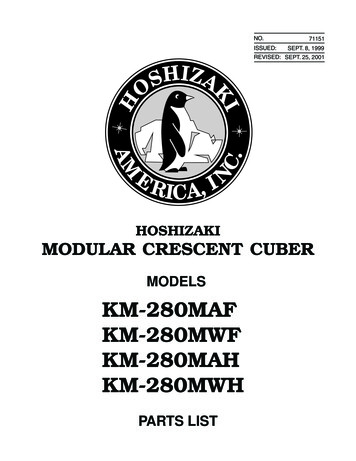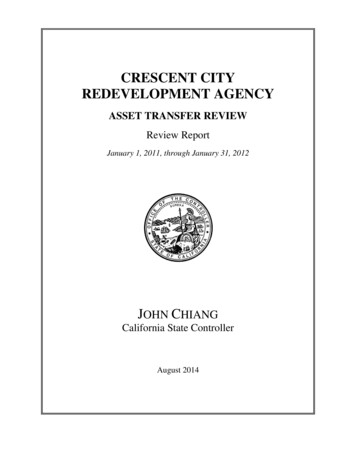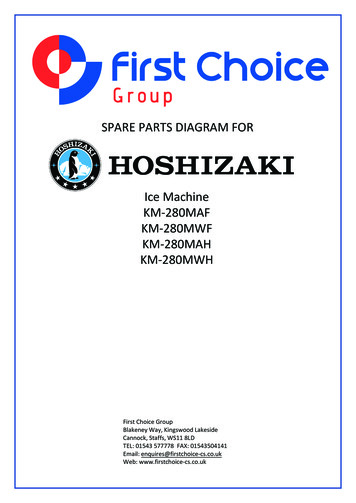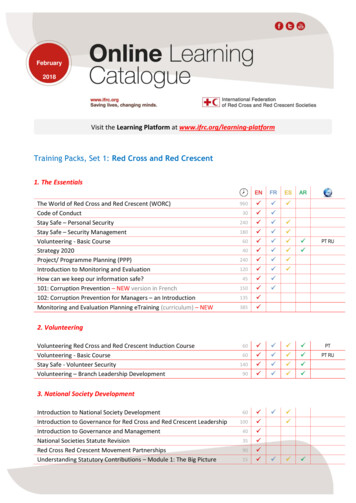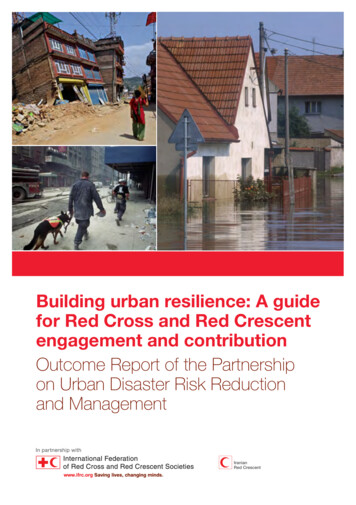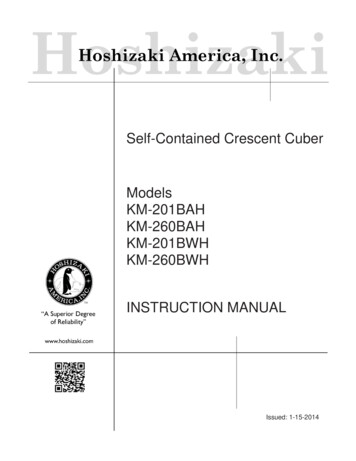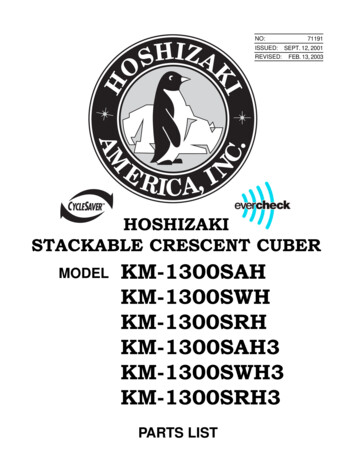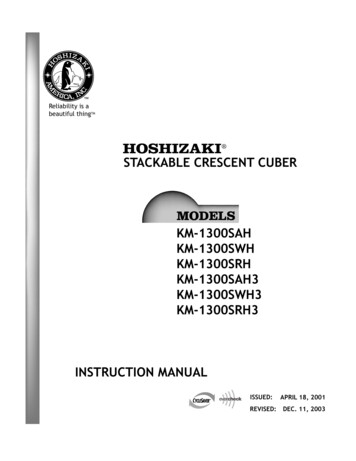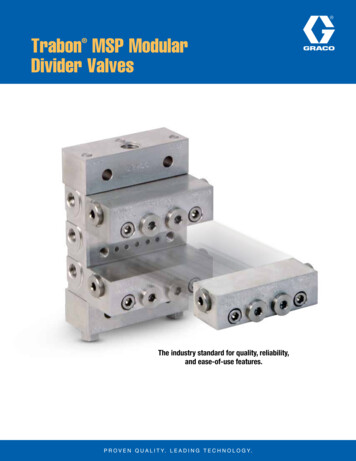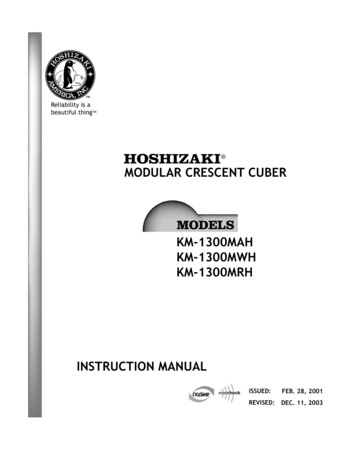
Transcription
Reliability is abeautiful thingTMMODULAR CRESCENT CUBERKM-1300MAHKM-1300MWHKM-1300MRHINSTRUCTION MANUAL ISSUED:FEB. 28, 2001REVISED:DEC. 11, 2003
IMPORTANTOnly qualified service technicians should attempt to install, service or maintain thisicemaker. No installation, service or maintenance should be undertaken until thetechnician has thoroughly read this Instruction Manual. Likewise, the owner/managershould not proceed to operate the icemaker until the installer has instructed them onits proper operation.HOSHIZAKI provides this manual primarily to assist qualified service technicians in theinstallation, maintenance and service of the icemaker.Should the reader have any questions or concerns which have not been satisfactorilyaddressed, please call or write to the HOSHIZAKI Technical Support Department forassistance.HOSHIZAKI AMERICA, INC.618 Highway 74 SouthPeachtree City, GA 30269Attn: HOSHIZAKI Technical Support DepartmentPhone: 1-800-233-1940 Technical Service(770) 487-2331Fax:(770) 487-3360NOTE:To expedite assistance, all correspondence/communication MUST include thefollowing information: Model Number Serial Number Complete and detailed explanation of the problem2
Please review this manual. It should be read carefully before the icemaker is installed andoperated. Only qualified service technicians should install, service and maintain theicemaker. This manual should be made available to the technician prior to installation,maintenance or service. Keep this manual with the icemaker for later reference.CONTENTSPAGEI. SPECIFICATIONS . 41. NAMEPLATE RATING . 4[a] KM-1300MAH (Air-cooled) . 4[b] KM-1300MWH (Water-cooled) . 5[c] KM-1300MRH (Remote Air-cooled) . 62. DIMENSIONS/CONNECTIONS . 7[a] KM-1300MAH . 7[b] KM-1300MWH . 8[c] KM-1300MRH . 9II. INSTALLATION AND OPERATING INSTRUCTIONS. 101. CHECKS BEFORE INSTALLATION . 102. HOW TO REMOVE PANELS . 103. LOCATION . 114. SET UP . 115. ELECTRICAL CONNECTION . 136. INSTALLATION OF REMOTE CONDENSER UNIT . 14[a] CHECKS BEFORE INSTALLATION . 14[b] LOCATION . 14[c] SET UP . 15[d] ELECTRICAL CONNECTION . 16[e] STACKING CONDENSER UNIT . 177. WATER SUPPLY AND DRAIN CONNECTIONS . 188. FINAL CHECK LIST . 209. START UP . 2110. PREPARING THE ICEMAKER FOR LONG STORAGE . 22III. CLEANING AND MAINTENANCE INSTRUCTIONS . 241. CLEANING INSTRUCTIONS . 24[a] CLEANING PROCEDURE . 25[b] SANITIZING PROCEDURE . 262. MAINTENANCE . 283
I. SPECIFICATIONS1. NAMEPLATE RATING[a] KM-1300MAH (Air-cooled)See the Nameplate for electrical and refrigeration specifications.This Nameplate is located on the upper right hand side of rear panel.Since this Nameplate is located on the rear panel of the icemaker, itcannot be read when the back of the icemaker is against a wall oragainst another piece of kitchen equipment. Therefore, the necessary electrical and refrigeration information is also on the ratinglabel, which can be easily seen by removing only the front panel ofthe icemaker.We reserve the right to make changes in specifications and design without prior notice.4
[b] KM-1300MWH (Water-cooled)See the Nameplate for electrical and refrigeration specifications.This Nameplate is located on the upper right hand side of rear panel.Since this Nameplate is located on the rear panel of the icemaker, itcannot be read when the back of the icemaker is against a wall oragainst another piece of kitchen equipment. Therefore, the necessary electrical and refrigeration information is also on the ratinglabel, which can be easily seen by removing only the front panel ofthe icemaker.We reserve the right to make changes in specifications and design without prior notice.5
[c] KM-1300MRH (Remote Air-cooled)See the Nameplate for electrical and refrigeration specifications.This Nameplate is located on the upper right hand side of rear panel.Since this Nameplate is located on the rear panel of the icemaker, itcannot be read when the back of the icemaker is against a wall oragainst another piece of kitchen equipment. Therefore, the necessary electrical and refrigeration information is also on the rating label, which can be easily seen by removing only the front panel ofthe icemaker.We reserve the right to make changes in specifications and design without prior notice.6
2. DIMENSIONS/CONNECTIONS[a] KM-1300MAHUnit: mm. (inches)7
[b] KM-1300MWHUnit: mm. (inches)8
[c] KM-1300MRHUnit: mm. (inches)9
II. INSTALLATION AND OPERATING INSTRUCTIONS1. CHECKS BEFORE INSTALLATIONIMPORTANT1. Remove shipping carton, tape(s) and packing. If packing material is left inthe icemaker, it will not work properly.2. Ensure all components, fasteners and thumbscrews are securely in place.1) Remove the panels to prevent damage when installing the icemaker. (See “2. HOW TOREMOVE PANELS.”)2) Remove the package containing the accessories.3) Remove the protective plastic film from the panels. If the icemaker is exposed to the sunor to heat, remove the film after the icemaker cools.4) Check that the refrigerant lines do not rub or touch lines or other surfaces, and that thefan blade turns freely.5) Check that the Compressor is snug on all mounting pads.6) See the Nameplate on the Rear Panel, and check that your voltage supplied corresponds with the voltage specified on the Nameplate.7) This icemaker needs a storage bin. The recommended storage bin is HOSHIZAKI ICESTORAGE BIN, Model B-500 series.8) On remote air-cooled models, a remote condenser unit is needed. The recommendedremote condenser unit is HOSHIZAKI CONDENSER UNIT, Model URC-12F.2. HOW TO REMOVE PANELS - See Fig. 1a) Front Panel.Remove the screw.Lift up and pull toward you.b) Top Panel. Lift up slightly its front, push away,and then lift off.c) Side Panel (R). Remove the screw.Pull slightly toward you, and lift off.d) Insulation Panel.Lift up slightly, and pull toward you.Note: If the Top Panel is still on, first liftit and slide it to the back a little.10Fig. 1
3. LOCATIONWARNINGThis icemaker is not intended for outdoor use. Normal operating ambienttemperature should be within 45 F to 100 F; Normal operating water temperature should be within 45 F to 90 F. Operation of the icemaker, forextended periods, outside of these normal temperature ranges may affectproduction capacity.For best operating results: Icemaker should not be located next to ovens, grills or other high heat producing equipment. Location should provide a firm and level foundation for the equipment. Allow 6" clearance at rear, sides and top for proper air circulation and ease of maintenance and/or service should they be required.4. SET UP1) Unpack the Storage Bin, and attach the four adjustable legs provided (bin accessory) tothe bottom of the Storage Bin.2) Position the Storage Bin in the selected permanent position.3) Place the icemaker on the top of the Storage Bin.4) Secure the icemaker to the Storage Bin, by using the two mounting brackets and thebolts provided. See Fig. 2.Fig. 211
CAUTIONBefore operating the icemaker, the Bin Control Thermostat Bulb must be setcorrectly.5) Set the Bin Control Thermostat Bulb as follows. See Fig. 3.(a) Take off the shipping tape securing the Thermostat Bulb Holder. Remove the Thermostat Bulb Holder from the Shipping Hook by lifting it up and shifting to the right.(b) Slide the Thermostat Bulb Holder down through the hole located in the bottom of theicemaker until it is placed in the Bracket.(c) Insert the Plug into the Receptacle on the Holder. Check to see that the Plug islocked into the Receptacle.6) Level the icemaker/Storage Bin in both the left-to-right and front-to-rear directions.Adjust the Ice Bin Legs to make the icemaker level.7) Replace the panels in their correct positions.Fig. 312
5. ELECTRICAL CONNECTIONWARNING1. Electrical connection must be made in accordance with the instructions ona “WARNING” tag, provided with the pig tail leads in the Junction Box.2. This icemaker requires a ground that meets the national and local electrical code requirements. To prevent possible electrical shock to individualsor extensive damage to the equipment, install a proper ground wire to theicemaker. The white lead must be connected to the neutral conductor of the power source. Miswiringresults in severe damage to the icemaker. See Fig. 4. This icemaker must have a separate power supply or receptacle of proper capacity. Seethe Nameplate. The opening for the power supply connection is 7/8" DIA to fit a 1/2" trade size conduit. Usually an electrical permit and services of a licensed electrician are required.WARNINGELECTRICAL CONNECTIONThe white lead must be connectedto the neutral conductor ofthe power source.Miswiring results in severedamage to the icemaker.(See Fig. below.)Fig. 413
6. INSTALLATION OF REMOTE CONDENSER UNIT[a] CHECKS BEFORE INSTALLATION1) Unpack and remove shipping carton, tape(s) and packing.2) Check that the refrigerant lines do not rub or touch lines or other surfaces, and that thefan blade moves freely.[b] LOCATIONThe condenser unit must be positioned in a permanent site under the following guidelines. A firm and flat site. A dry and well ventilated area with 24" clearance on both front and rear for ease of maintenance and service should they be required. Normal condenser ambient temperature: -20 F to 122 F. Temperatures not within thisoperating range may affect the production capacity of the icemaker. The maximum line length for the standard refrigerant charge is 66 feet. Should an installation require a longer line length, please call 1-800-233-1940 for recommendationsconcerning the correct additional refrigerant charge to be added.AirAirFig. 5Note: If the recommended guidelines of the installation are exceeded,the icemaker performance may be reduced.14
[c] SET UP1) Secure the Legs to the condenser unit with eight M8 x 16 mm Hexagon Bolts and M8Nuts as shown in the illustration. See Fig. 6.Note: Locate the Legs symmetrically.2) The Legs have eight mounting holes. Secure the Legs with eight bolts (not included).3) Install enough length of two copper tubings provided with Aeroquip couplings betweenthe icemaker and the condenser unit. The two copper tubings should be insulated separately. See Fig. 7. Precharged tubing kits, available as optional equipment from HOSHIZAKI AMERICA,are recommended .4) Line sets fabricated in the field should be evacuated through the charging ports on theAeroquip couplings and charged with R-404A refrigerant vapor to a pressure of 15 - 30PSIG.Note: Factory fabricated tubing kits are precharged and do not need to be evacuated.5) Remove the plastic caps protecting the couplings. Attach the two refrigerant lines to themale couplings on the icemaker and the remote condenser unit. Each refrigerant linemust be connected as follows:Icemaker discharge refrigerant line - 1/2" OD tubing to “DIS” of condenser unitIcemaker liquid refrigerant line - 3/8" OD tubing to “LIQ” of condenser unitNote: Make the connections at the remote condenser first and then at the icemaker.Fig. 6Fig. 715
[d] ELECTRICAL CONNECTIONWARNINGThis remote condenser unit requires a ground that meets the national andlocal electrical code requirements. To prevent possible electrical shock toindividuals or extensive damage to equipment, install a proper ground wireto this condenser unit. This condenser unit must be connected to the Fan Motor Junction Box on the icemaker. The opening for the power supply connection is 7/8" DIA to fit a 1/2" trade size conduit. Usually an electrical permit and services of a licensed electrician are required.1) Remove the Panel.2) Remove the Junction Box Cover.3) Connect the Fan Motor leads in the Junction Box of the remote condenser unit to the FanMotor leads in the Junction Box of the HOSHIZAKI remote air-cooled icemaker.4) Install a ground wire to the remote condenser unit.5) Replace the Junction Box Cover and the Panel in their correct position.Fig. 816
[e] STACKING CONDENSER UNIT1) Secure the lower condenser unit to the Legs with eight bolts (not included).2) Attach the upper condenser unit on the top of the lower.3) Secure the upper condenser unit with the four screws provided.4) Install refrigerant lines, and make electrical connection for each Fan Motor as shown inItems [c] and [d].Fig. 917
7. WATER SUPPLY AND DRAIN CONNECTIONS - See Fig. 10IMPORTANTTo prevent damage to the pump assembly, do not operate the icemaker whenthe water supply is OFF, or if the pressure is below 10 PSIG. Do not run theicemaker until the proper water pressure is reached. Water supply inlet is 1/2" female pipe thread (FPT).Note: On water-cooled model, two water supply inlets are provided.One is for the icemaker, and the other is for the water-cooledcondenser. A water supply line shut-off valve and drain valve should be installed. A minimum of 1/2"OD copper tubing is recommended for the water supply lines. Water supply pressure should be a minimum of 10 PSIG and a maximum of 113 PSIG. Ifthe pressure exceeds 113 PSIG, the use of a pressure reducing valve is required. Drain outlet for icemaker dump is 3/4" FPT. The drain for condensation is a 3/8" ID pipe.The icemaker drain and the condenser drain piping connections must be made separately from the bin drain.Note: On water-cooled model, a 3/8" FPT is provided for the condenser drain outlet. The drains must have 1/4" fall per foot on horizontal runs to get a good flow. The drains should not be piped directly to the sewer system. An air gap of a minimum of2 vertical inches should be between the end of the drain pipe from the icemaker or theice bin and the floor drain. This icemaker should be installed in accordance with applicable national, state and localregulations. A plumbing permit and services of a licensed plumber may be required in some areas. In some areas, a back flow preventer may be required in the cooling water circuit.18
KM-1300MAHKM-1300MRHKM-1300MWHFig. 1019
8. FINAL CHECK LIST1) Is the icemaker level?2) Is the icemaker in a site where the ambient temperature is within 45 F to 100 F allyear around?3) Is there at least 6" clearance around the icemaker for maintenance or service?4) Have all shipping carton, tape(s) and packing been removed from the icemaker? Arethe cube guides in their correct position?5) Are all components, fasteners and thumbscrews securely in place?6) Have all electrical and piping connections been made?7) Has the power supply voltage been checked or tested against the nameplate rating?And has a proper ground been installed in the icemaker?8) Are the Water Supply Line Shut-off Valve and Drain Valve installed? Has the watersupply pressure been checked to ensure a minimum of 10 PSIG and a maximum of 113PSIG?Note: The icemaker may stop running when the water supply is OFF, or if the pressureis below 10 PSIG. When the proper water pressure is reached, the icemakerautomatically starts running again.9) Have the compressor hold-down bolts and refrigerant lines been checked against vibration and possible failure?10) Has the Bin Control Switch been checked for correct operation? When the icemaker isrunning, hold an ice cube in contact with the Bulb. The icemaker should stop within 6to 10 seconds.11) Has the end user been given the instruction manual, and instructed on how to operatethe icemaker and the importance of the recommended periodic maintenance?12) Has the end user been given the name and telephone number of an authorized serviceagent?13) Has the warranty tag been filled out and forwarded to the factory for warrantyregistration?20
9. START UPIMPORTANT1. All parts are factory-adjusted. Improper adjustments may result in failure.2. If the unit is turned off, wait for at least 3 minutes before restarting theicemaker to prevent damage to the Compressor.3. Do not operate the unit in the “WASH” position without water in the WaterTank. This will cause damage to the Water Pump seal.1) Open the Water Supply Line Shut-off Valve.2) Remove the Front Panel.3) Move the Control Switch, on the Control Box, to the “ICE” position.4) Replace the Front Panel in its correct position.5) Turn on the power supply, and allow the Water Tank to fill with water and the icemaker tooperate for a total of 10 minutes.6) Turn off the power supply, and remove the Front Panel and the Insulation Panel by firstlifting the Top Panel and sliding the Top Panel to the back a little.7) Remove the Rubber Cap covering the Overflow Pipe in the Water Tank. Remove theOverflow Pipe by turning it counterclockwise. Drain the Water Tank. See Fig. 11.8) Replace the Overflow Pipe, the Rubber Cap, the Insulation Panel and the Front Panelin their correct position.9) Clean the Storage Bin.10) Turn on the power supply, and start the automatic icemaking process.Fig. 1121
10 . PREPARING THE ICEMAKER FOR LONG STORAGEIMPORTANTWhen shutting off the icemaker for an extended time, drain out all water fromthe water line and remove the ice from the Storage Bin. The Storage Binshould be cleaned and dried. Drain the icemaker to prevent damage to thewater supply line at sub-freezing temperatures, using air or carbon dioxide.Shut off the icemaker until the proper ambient temperature is resumed. When the icemaker is not used for two or three days, it is sufficient to only move theControl Switch to the "OFF" position, unless the icemaker will be at sub-freezing temperatures.[1] On water-cooled model only, first remove the water from the water-cooled condenser:1) Remove the Front Panel.2) Move the Control Switch, on the Control Box, to the “OFF” position.3) Wait 3 minutes.4) Move the Control Switch to the “ICE” position.5) Allow 5 minutes for the icemaker to fill with water and the Water Pump to start operating.6) Close the Water-cooled Condenser Water Supply Line Shut-off Valve. See Fig. 10.7) Open the Drain Valve for the water-cooled condenser water supply line.8) Allow the line to drain by gravity.9) Attach compressed air or carbon dioxide supply to the Condenser Water Line DrainValve.10) Blow the water-cooled condenser out using compressed air or carbon dioxide untilwater stops coming out.22
[2] Remove the water from the potable water supply line:1) Remove the Front Panel. (Except water-cooled model)2) Move the Control Switch, on the Control Box, to the “OFF” position.3) Wait 3 minutes.4) Close the Potable Water Supply Line Shut-off Valve and open the Potable Water SupplyLine Drain Valve. See Fig. 10.5) Allow the line to drain by gravity.6) Attach compressed air or carbon dioxide supply to the Potable Water Line Drain Valve.7) Move the Control Switch to the “ICE” position.8) Quickly blow the potable water line out using compressed air or carbon dioxide.[3] Drain the Potable Water Tank:1) Turn off the power supply.2) Move the Control Switch, on the Control Box, to the “OFF” position.3) Remove the Insulation Panel.4) Remove the Rubber Cap covering the Overflow Pipe in the Water Tank. Remove theOverflow Pipe by turning it counterclockwise. Drain the Water Tank. See Fig.11.5) Replace the Overflow Pipe, the Rubber Cap and the Insulation Panel in their correctposition.6) Remove all ice from the Storage Bin, and clean the Storage Bin.7) Replace the Front Panel in its correct position.23
III. CLEANING AND MAINTENANCE INSTRUCTIONSIMPORTANTEnsure all components, fasteners and thumbscrews are securely in placeafter any maintenance or cleaning is done to the equipment.1. CLEANING INSTRUCTIONSWARNING1. HOSHIZAKI recommends cleaning this unit at least once a year. Morefrequent cleaning, however, may be required in some existing water conditions.2. To prevent injury to individuals and damage to the icemaker, do not useammonia type cleaners.3. Always wear liquid-proof gloves for safe handling of the cleaning and sanitizing solution. This will prevent irritation in case the solution comes intocontact with the skin.IMPORTANT1. The Cleaning Valve is used to provide access to the inside of the Evaporator during the cleaning and sanitizing operation. It should be closed forall icemaking operation. The Compressor will not operate unless thisvalve is completely closed.2. To open the Cleaning Valve, the Valve Handle should be parallel to thevalve body. To close the valve, the Valve Handle should be at a rightangle to the valve body.24
[a] CLEANING PROCEDURE1) Dilute approximately 27 fl. oz. of recommended cleaner Hoshizaki “Scale Away” or“LIME-A-WAY,” (Economics Laboratory, Inc.) with 5 gallons of water.2) Remove all ice from the Evaporator and the Storage Bin.Note: To remove cubes on the Evaporator, turn off the power supply andturn it on after 3 minutes. The defrost cycle starts and the cubeswill be removed from the Evaporator.3) Turn off the power supply.4) Remove the Front Panel, and then remove the Insulation Panel by first lifting the TopPanel and sliding the Top Panel to the back a little.5) Remove the Rubber Cap covering the Overflow Pipe in the Water Tank. Remove theOverflow Pipe by turning it counterclockwise. Drain the Water Tank. See Fig. 11.6) Replace the Overflow Pipe and the Rubber Cap in their correct position.7) Pour the cleaning solution into the Water Tank.8) Fully open the Cleaning Valve on the left side wall of the machine compartment.9) Move the Control Switch, on the Control Box, to the “WASH” position10) Replace the Insulation Panel and the Front Panel in their correct position.Note: When replacing the Insulation Panel, do not catch the Hosebetween the panel and the body.11) Turn on the power supply, and start the washing process.12) Turn off the power supply after 30 minutes.13) Remove the Front Panel, and then remove the Insulation Panel by first lifting the TopPanel and sliding the Top Panel to the back a little.14) Remove the Rubber Cap covering the Overflow Pipe in the Water Tank. Remove theOverflow Pipe by turning it counterclockwise. Drain the Water Tank. Replace the Overflow Pipe, the Rubber Cap and the Insulation Panel in their correct position.15) Move the Control Switch to the “ICE” position.16) Close the Cleaning Valve.25
17) Replace the Front Panel in its correct position.18) Turn on the power supply to fill the Water Tank with water.19) Turn off the power supply after 3 minutes.20) Remove the Front Panel, and fully open the Cleaning Valve.21) Move the Control Switch to the “WASH” position.22) Replace the Front Panel in its correct position.23) Turn on the power supply to rinse off the cleaning solution.24) Turn off the power supply after 5 minutes.25) Remove the Front Panel, and then remove the Insulation Panel by first lifting the TopPanel and sliding the Top Panel to the back a little.26) Remove the Rubber Cap covering the Overflow Pipe in the Water Tank. Remove theOverflow Pipe by turning it counterclockwise. Drain the Water Tank. Replace the Overflow Pipe, the Rubber Cap and the Insulation Panel in their correct position.Note: Do not replace the Insulation Panel when you proceed to“[b] SANITIZING PROCEDURE.”27) Repeat the above steps 15) through 26) three more times to rinse thoroughly.Note: If you do not sanitize the icemaker, go to the step 9) in “[b] SANITIZINGPROCEDURE.”[b] SANITIZING PROCEDURE - Following Cleaning Procedure1) Dilute a 5.25% Sodium Hypochlorite solution (chlorine bleach) with water(Add approximately 2.5 fl. oz. to 5 gal. of water).2) Pour the sanitizing solution into the Water Tank.3) Replace the Insulation Panel and the Front Panel in their correct position.Note: Make sure that the Control Switch is in the “WASH” positionand the Cleaning Valve is open.4) Turn on the power supply, and start the sanitizing process.26
5) Turn off the power supply after 15 minutes.6) Remove the Front Panel, and then remove the Insulation Panel by first lifting the Top Paneland sliding the Top Panel to the back a little.7) Remove the Rubber Cap covering the Overflow Pipe in the Water Tank. Remove the Overflow Pipe by turning it counterclockwise. Drain the Water Tank. Replace the OverflowPipe, the Rubber Cap and the Insulation Panel in their correct position.8) Repeat the above steps 15) through 26) in “[a] CLEANING PROCEDURE” two times torinse thoroughly.9) Close the Cleaning Valve.10) Move the Control Switch to the “ICE” position.11) Replace the Front Panel in its correct position.12) Clean the Storage Bin with water.13) Turn on the power supply, and start the automatic icemaking process.27
2. MAINTENANCEIMPORTANTThis icemaker must be maintained individually, referring to the instructionmanual and labels provided with the icemaker.1) Stainless Steel ExteriorTo prevent corrosion, wipe the exterior occasionally with a clean and soft cloth. Usea damp cloth containing a neutral cleaner to wipe off oil or dirt build up.2) Storage Bin and Scoop Wash your hands before removing ice. Use the Plastic Scoop provided (BinAccessory). The Storage Bin is for ice use only. Do not store anything else in the Bin. Keep the Scoop clean. Clean it by using a neutral cleaner and rinse thoroughly. Clean the bin liner by using a neutral cleaner. Rinse thoroughly after cleaning.3) Air Filter (Air-cooled model only)A plastic mesh air filter removes dirt or dust from the air, and keeps the Condenserfrom getting clogged. As the Filter gets clogged, the icemaker’s performance will bereduced. Check the Filter at least twice a month. When clogged, use warm waterand a neutral cleaner to wash the Filter.4) Condenser (Except Water-cooled model)Check the Condenser once a year, and clean if required by using a brush or vacuumcleaner. More frequent cleaning may be required depending on the location of theicemaker.28
HOSHIZAKIHOSHIZAKI AMERICA, INC.618 HIGHWAY 74 SOUTHPEACHTREE CITY, GA 30269U.S.A.PHONE: 770-487-23312991A1OD10B
INSTRUCTION MANUAL ISSUED: FEB. 28, 2001 KM-1300MAH KM-1300MWH KM-1300MRH MODULAR CRESCENT CUBER Reliability is a beautiful thingTM REVISED: DEC. 11, 2003
